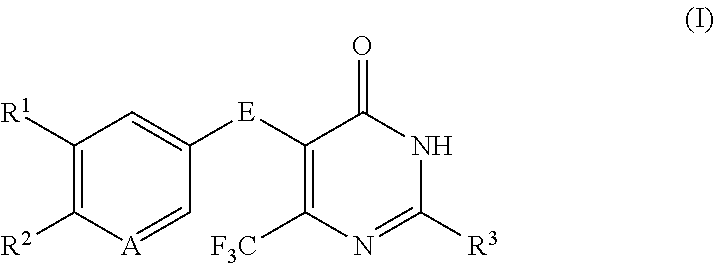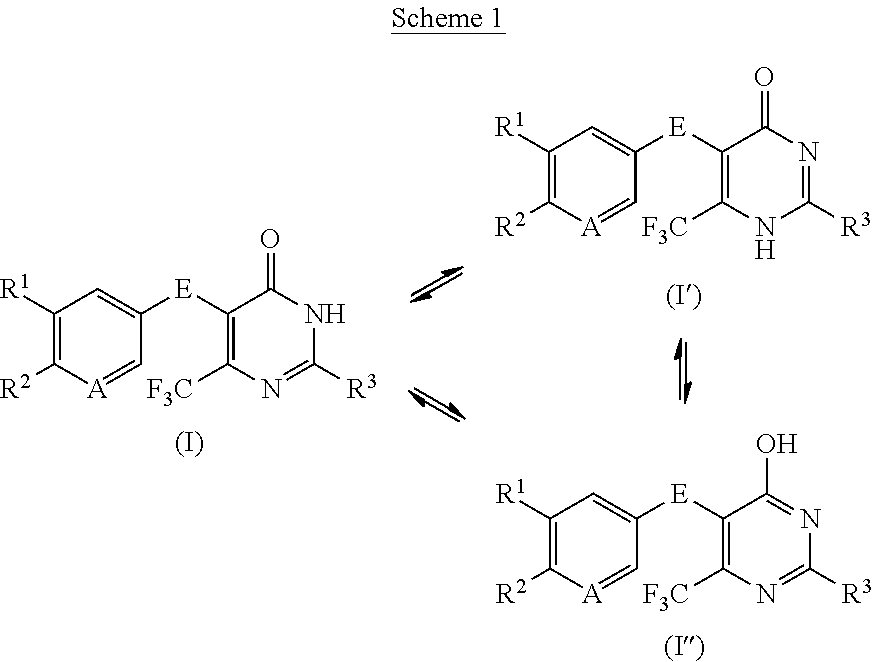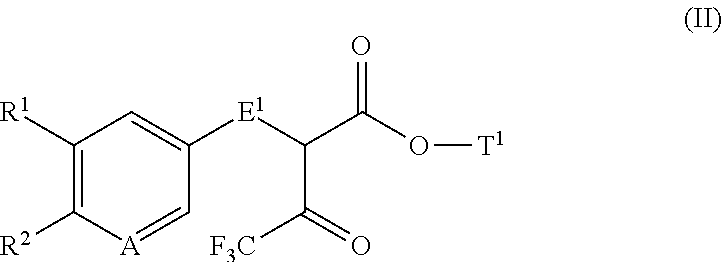Disubstituted trifluoromethyl pyrimidinones and their use
a technology of trifluoromethyl pyrimidinone and substituted trifluoromethyl pyrimidinone, which is applied in the direction of drug compositions, cardiovascular disorders, organic chemistry, etc., can solve the problems of damage to cardiomyocytes which have survived
- Summary
- Abstract
- Description
- Claims
- Application Information
AI Technical Summary
Benefits of technology
Problems solved by technology
Method used
Image
Examples
example 1a
Ethyl 2-[4-chloro-3-(trifluoromethyl)phenoxy]acetate
[0321]
[0322]At 23° C. (cooling !), 25 g (127.2 mmol) of 4-chloro-3-(trifluoromethyl)phenol in 50 ml of THF were added dropwise to a suspension of 5.6 g (140 mmol) of sodium hydride (60% in paraffin) in 125 ml of THF, with evolution of hydrogen in an exothermic reaction. After 30 min of stirring, 23.4 g (140 mmol) of ethyl bromoacetate in 50 ml of THF were added dropwise, and the mixture was stirred at 23° C. for 2 h. Another 2.34 g of ethyl bromoacetate were added, and the mixture was stirred at 23° C. for a further 2 h. The mixture was then diluted with ethyl acetate and washed with water, and the aqueous phase was re-extracted with ethyl acetate. The combined organic phases were washed with water and dried over sodium sulphate. After removal of the drying agent by filtration, the mixture was concentrated under reduced pressure. Drying under high vacuum gave 38.3 g (96% of theory, purity 90%) of the target compound. The product co...
example 2a
Ethyl 2-[4-fluoro-3-(trifluoromethyl)phenoxy]acetate
[0325]
[0326]At 23° C., 2 g (11.1 mmol) of 4-fluoro-3-(trifluoromethyl)phenol were added dropwise to a suspension of 0.49 g (12.2 mmol) of sodium hydride (60% in paraffin) in 25 ml of THF, with evolution of hydrogen in an exothermic reaction. After 30 min of stirring, 1.86 g (11.1 mmol) of ethyl bromoacetate were added, and the mixture was stirred at 23° C. for 18 h. The mixture was then diluted with ethyl acetate and washed with water, and the organic phase was dried over magnesium sulphate. After removal of the drying agent by filtration, the mixture was concentrated under reduced pressure. Drying under high vacuum gave 2.43 g (78% of theory, purity 95%) of the target compound.
[0327]LC-MS (Method 3): Rt=2.42 min; MS (ESpos): m / z=267 (M+H)+.
[0328]The following compounds are known from the literature, commercially available or can be prepared analogously to Example 2A:
TABLE 1ExampleNo.IUPAC name / structureCAS number; literature3Aethy...
example 9a
Ethyl 2-14-chloro-3-(trifluoromethyl)phenoxyl-4,4,4-trifluoro-3-oxobutanoate
[0329]
[0330]Initially 26 g (182.8 mmol) of ethyl trifluoroacetate and then 38.3 g (121.9 mmol, purity 90%) of ethyl [4-chloro-3-(trifluoromethyl)phenoxy]acetate were added dropwise to a suspension of 12.19 g (304.7 mmol) of sodium hydride (60% in paraffin) in 150 ml of toluene. The mixture was heated to reflux, resulting in a noticeable evolution of gas, and boiled for one hour. The cooled reaction was then acidified with 1 N hydrochloric acid. The organic phase was separated off, washed with dilute brine, dried over sodium sulphate and filtered, and the filtrate was concentrated. Drying under high vacuum gave 50.6 g (76% of theory, purity 69%) of the target compound. The product was converted further without further purification.
[0331]LC-MS (Method 3): Rt=2.51 min; MS (ESneg): m / z=377 (M−H)−.
[0332]The following synthesis intermediates were prepared analogously to Example 9A:
TABLE 2ExampleIUPAC name / structur...
PUM
| Property | Measurement | Unit |
|---|---|---|
| pressure | aaaaa | aaaaa |
| temperature | aaaaa | aaaaa |
| temperature | aaaaa | aaaaa |
Abstract
Description
Claims
Application Information
 Login to View More
Login to View More - R&D Engineer
- R&D Manager
- IP Professional
- Industry Leading Data Capabilities
- Powerful AI technology
- Patent DNA Extraction
Browse by: Latest US Patents, China's latest patents, Technical Efficacy Thesaurus, Application Domain, Technology Topic, Popular Technical Reports.
© 2024 PatSnap. All rights reserved.Legal|Privacy policy|Modern Slavery Act Transparency Statement|Sitemap|About US| Contact US: help@patsnap.com










